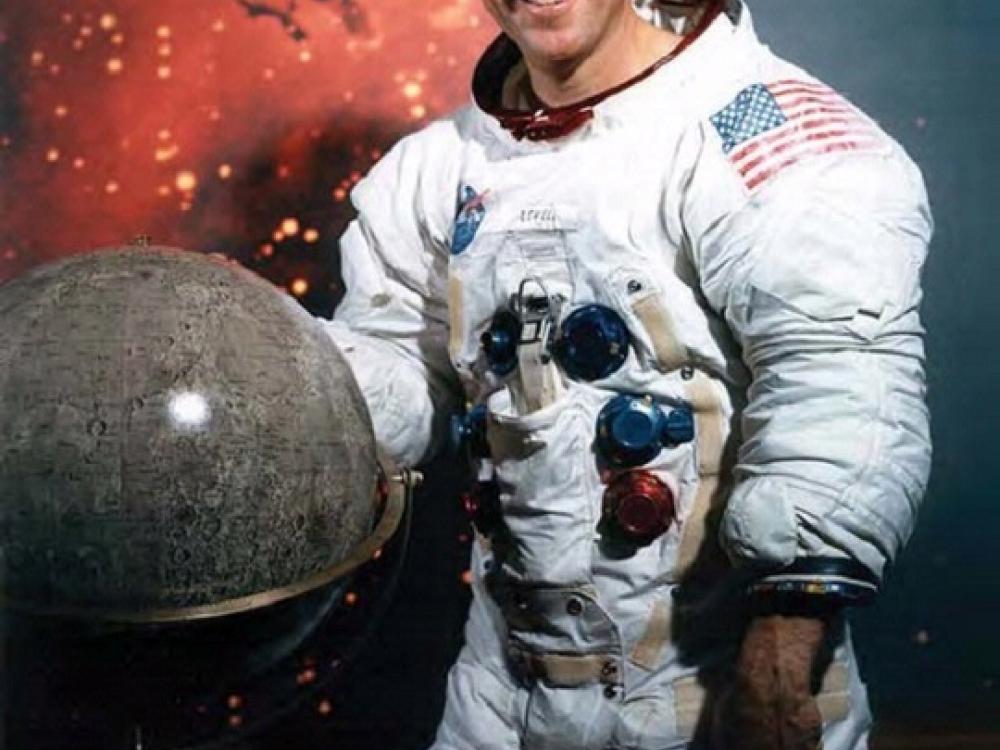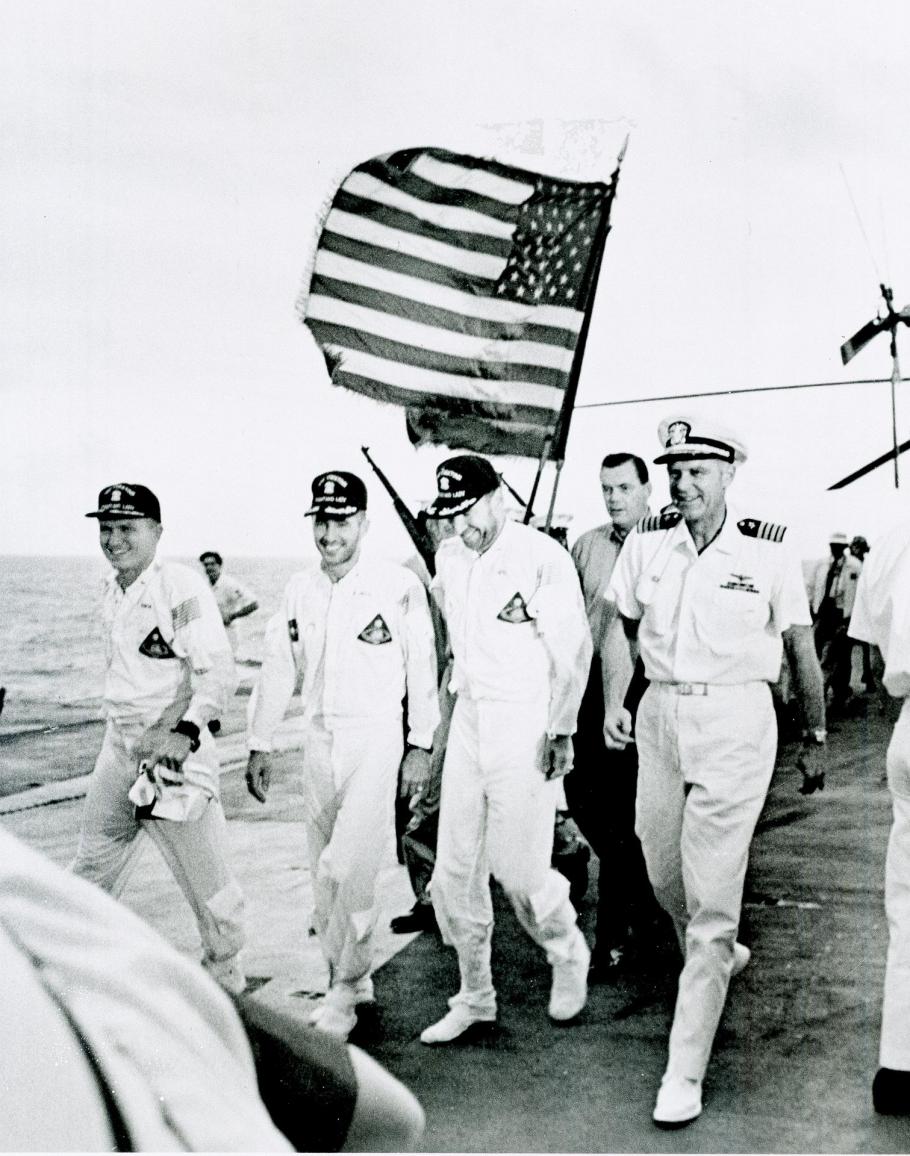Apollo 8 Astronaut Remembers Looking Down at Earth

Apollo 8 was the first human mission to the Moon, and its crew were the first people to see the far side with their own eyes. The mission’s dramatic highlights included a live Christmas Eve broadcast during which the astronauts read verses from the Book of Genesis in lunar orbit, and the iconic Earthrise photo.
Capt. James A Lovell, Apollo 8 astronaut, shared his memories of that historic mission at our Spirit of Apollo, 50th anniversary celebration. Below are a portion of his remarks.
My next assignment was Apollo 8, an Earth orbital flight scheduled for December, 1968, to check out the newly developed Lunar Module. My companions were Frank Borman and Bill Anders. I flew with Borman on Gemini 7. Anders was a rookie assigned the Lunar Pilot position. This mission would give him experience with the Lunar Module for a possible later lunar flight.
Two incidents occurred in the summer of 1968 that changed our mission and the history of Apollo. Grumman Aircraft Company, the maker of the Lunar Module informed NASA that a Lunar Module would not be ready for delivery before early 1969. Suddenly Apollo 8 did not have a mission.
To me this would be a mini Lewis and Clark expedition, exploring new territory on the Moon's far side.
Next, we received intelligence that the Russians planned to launch a manned circumlunar flight in December, 1968. They were serious. They flew the unmanned Zond 5 spacecraft around the moon in September, followed by Zond 6 in November. Zond 7 was being prepared for a manned flight in December.
It was George Low, Manager of the Apollo Program who had the brilliant idea: If Apollo 7’s 10 day Earth orbit flight in mid-October to certify the Apollo Command/Service Module is successful, then launch Apollo 8’s command/service module to the moon – not just to circumnavigate, but to go into lunar orbit.
Low figured the flight would shorten the time to a lunar landing. It would test the navigation and communications systems, check the effects of the Moon’s mass concentration on an orbiting spacecraft, look for suitable future landing areas, provide close-up photography and finally give America the uplift it needed.
We had just four months to prepare for the flight. NASA management had to be convinced. The Saturn V booster still had problems. The navigation and communications systems needed upgrading and Apollo 7 had to be successful.
To Borman, the change in Mission answered his dream – to beat the Russians to the Moon. He had no interest in exploration. Anders, at first, was disappointed not to test the Lunar Module, a step toward a lunar landing flight. I was delighted. To me this would be a mini Lewis and Clark expedition, exploring new territory on the Moon's far side.
It all came together on the early morning of December 21, 1968. Crossing the bridge from the launch tower to the spacecraft I saw, 360 feet below, the lights of the press vehicles driving into the press site. Suddenly I realized, I am actually going to the Moon. All that navigational training I had was for real.
Then, looking up I saw it, the Earth, a blue and white ball, just above the lunar horizon, 240,000 miles away.
At 0721 Apollo 8 started its journey. There had been no sign of a Russian launch. The third stage of our booster put us on a long elliptical orbit with its apogee intercepting the Moon three days later.
We entered lunar orbit on the dark side, and the Moon, nowhere to be seen. As we continued to orbit, shards of sunlight started to illuminate the peaks of craters just 60 miles below. Finally the far side was bathed in sunlight and we stared in silence as the ancient far side craters slowly passed underneath. I was observing alive that part of the Moon that had been hidden from man for millions of years.
Then, looking up I saw it, the Earth, a blue and white ball, just above the lunar horizon, 240,000 miles away.
–William Anders, Apollo 8, December 24, 1968
I thought, my world is only as far as the eye can see. In the country, mountains, hills or a grove of trees can restrict my world. In cities, tall buildings define my world and in this cathedral, our world exists within these walls. But seeing the Earth at 240,000 miles, my world suddenly expanded to infinity.
I put my thumb up to the window and completely hid the Earth. Just think, over five billion people, everything I ever knew was behind my thumb.
As I observed the Earth, I realized my home is a small planet, one of nine in the Solar System. It is just a mere speck in our Milky Way galaxy and lost to oblivion in the universe.
I began to question my own existence. How do I fit in to what I see? Then I remembered a saying I often heard: “I hope I go to Heaven when I die.” I suddenly realized that I went to Heaven when I was born! I arrived on a planet with the proper mass to have the gravity to contain water and an atmosphere, the essentials for life. I arrived on a planet orbiting a star at just the right distance to absorb that stars energy—energy that caused life to evolve in the beginning.
In my mind the answer was clear. God gave mankind a stage upon which to perform. How the play ends, is up to us.
Apollo 8 slowly orbited to the familiar, near side and friendly landmarks came into view. First was the crater Langrenus with its terraced walls. Then Messier in the Sea of Fertility. Ahead I could see the Secche Mountain Range winding its way down to the Sea of Tranquility. On Tranquility’s shore, I found Mt. Marilyn, a small triangular mountain that would soon be the “stepping stone” for the first lunar landing.
Apollo 8 astronauts and commanding officer of the recovery ship U.S.S. Yorktown walk the red carpet of the flight deck after splashdown recovery in the Pacific Ocean. Credit: NASA
By all means the flight of Apollo 8 was a complete success. All spacecraft systems functioned as planned. Navigation and communications operations proved their worth. The timing of the flight–orbiting the moon at Christmas provided a spiritual environment to read the first 10 versus of Genesis to an audience on Earth.
Borman got his wish to beat the Russians to the Moon. Anders became a celebrity for his famous Earthrise photo and that one photo provided convincing evidence that many nations are but one world. As for me, the flight prepared me for my next lunar mission–Apollo 13–but that’s another story.
It was the American public however, that received the greatest gift. After a year of controversy, Apollo 8 gave them a reason to be American.
The flight of Apollo 8 can best be expressed by a telegram received by the crew. It only said “Thanks – you saved 1968.”
The following July I was asked to escort Charles Lindbergh to watch the launch of Apollo 11. As we listened to the countdown, I said “Take a look at that Saturn V rocket. The spacecraft on top will try to land on the Moon.” But I could tell he was in deep thought, his mind elsewhere. I suspected he was thinking of his own voyage, that perilous 34 hour over water flight from New York to Paris.
Suddenly he answered “Apollo 11 will be quite an accomplishment. But your flight–Apollo 8– that initial 240,000 mile voyage from the Earth to the Moon. That’s the flight I will remember”.
Related Topics
You may also like
We rely on the generous support of donors, sponsors, members, and other benefactors to share the history and impact of aviation and spaceflight, educate the public, and inspire future generations. With your help, we can continue to preserve and safeguard the world’s most comprehensive collection of artifacts representing the great achievements of flight and space exploration.


